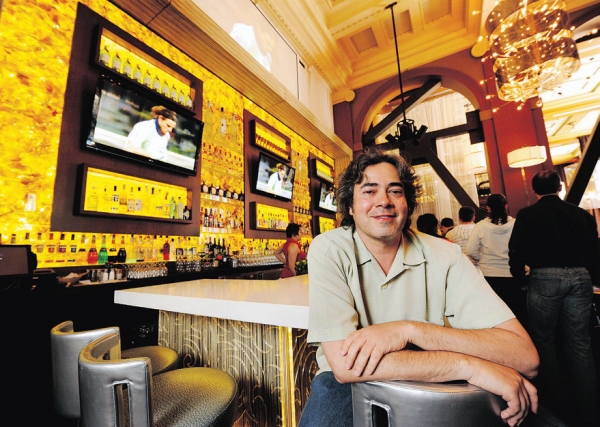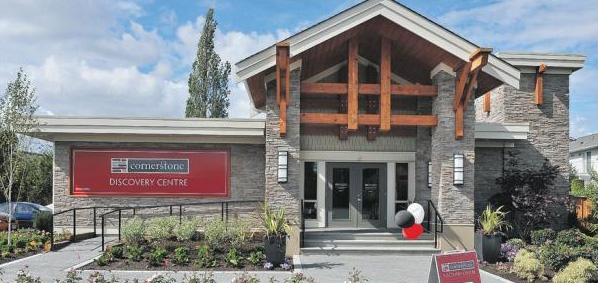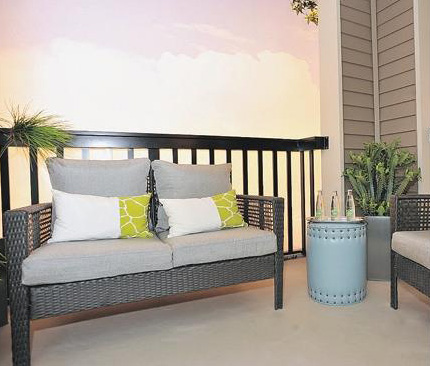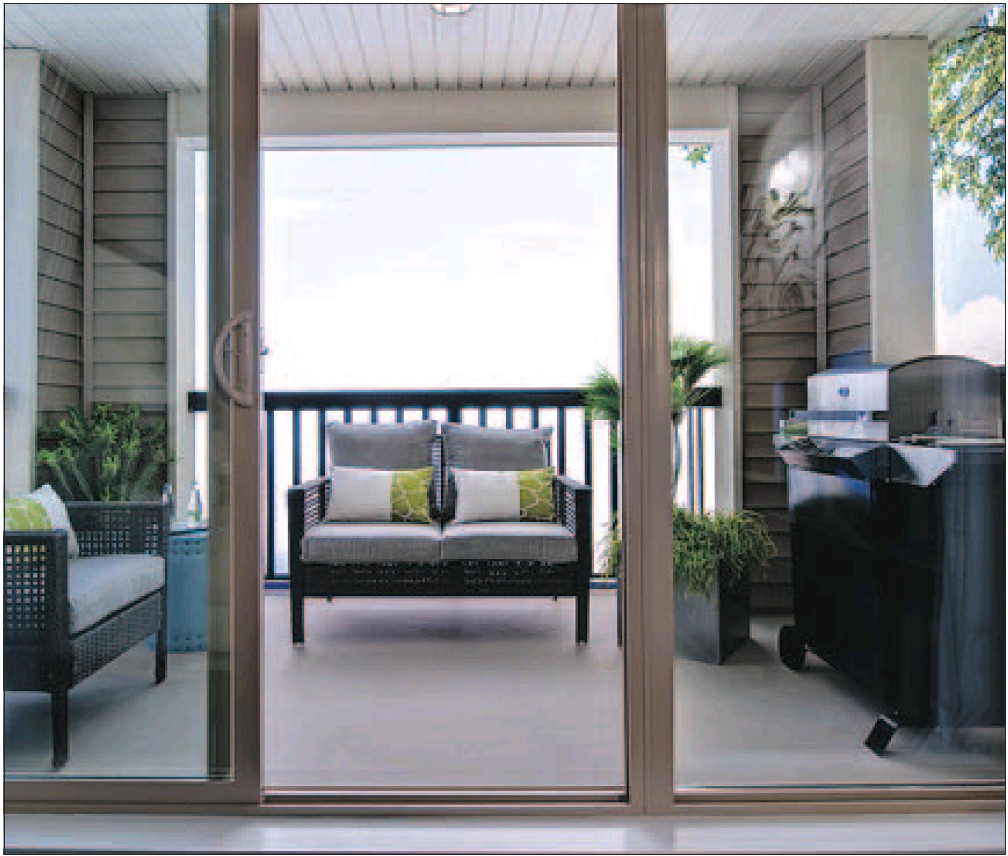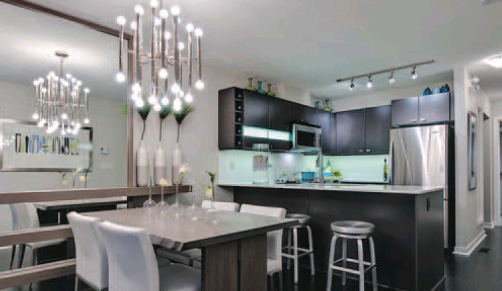Forget square footage, parking spots and conventional real-estate rules when selling a home. Some deals are sealed thanks to the quirkiest of features, as At Home reveals
Mary Frances Hill
Sun
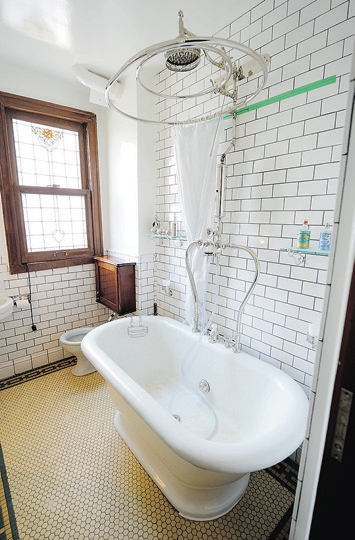
Robert McNutt’s antiques in his old Mount Pleasant apartment. One of several antique light fixtures, and McNutt’s kitchen. His unique ‘cooling cabinet’ and the 100-year-old bathtub with its rainshower shower head. Photograph by: Mark Van Manen, Special To The Sun / Png
When is a hole in a kitchen wall a good thing? When it doubles as a unique refrigerator, Mary Frances Hill discovers
Robert McNutt’s Mount Pleasant apartment is like none other in the city, thanks to his eye for antiques and an ability to live without modern conveniences.
Nearly every inch of the century-old, 600-square-foot apartment rented by the restorer of antique lighting is covered in vintage flair. In the elaborate bathroom, for example, a sink spigot hails from the early days of the Bank of Nova Scotia at Granville and Davie, and the 100-year-old bathtub is fitted with a web of silver-exposed piping leading to a rainshower shower head.
Call it Mr. McNutt’s Wonder Emporium.
McNutt is a fervent collector, and a careful one. He gets his dates right, acquiring items from 1870 to 1915 only, to match the era of the apartment block where he’s made his home for the past 15 years. There’s the antique fireplace delivered from Cleveland, the doorknob from the Vanderbilts‘ summer house in Newport, Rhode Island, and the rebuilt vintage chandeliers in every room.
But it is when McNutt, who works at Architectural Antiques on Main Street, describes his inner sanctum to people who have not had the fortune to visit, that attention is drawn to one of the oddest pieces: The so-called cooling cabinet.
The concept is deceptively simple. A hole in the upper kitchen wall brings a breeze that circulates straight into — and up and down — the cabinet. McNutt stores his food on the cabinet’s six shelves, constructed from strong mesh.
Without the ability to freeze food ( “Who needs ice? It’s overrated,” he says) or keep produce fresh in the cabinet for long periods, McNutt shops more like the Europeans, purchasing food every few days. And that has benefited both his health and social life.
“When people have refrigerators, you find science experiments [with your produce],” he says. “The way I shop, you develop a bond with the people you buy your food from because you see them every day.”
Still, there are drawbacks. “I found a pigeon trying to make a nest in my ‘fridge,'” he adds.
When McNutt moved in, he was also surprised to see an access point for a vacuum on the wall near the entrance to his suite, and discovered the apartment block boasted a vintage central system.
Finally, after a decade looking online and in antique stores in various cities, he found a woman in Baltimore wanting to sell the circa-1910 contraption on eBay. “I had been looking to the ends of the earth for this,” he says.
After some wrangling, he bought it for $26, paid $1,000 for the delivery from Baltimore, and another $1,000 for additional pipes and parts. His landlord allowed him to install the body of the system — or what he calls “the mother ship” — in the building’s basement.
McNutt blames his predilection for purchasing such rarities on his association with fellow hoarders, eccentrics, collectors and antiques buffs. He also scours eBay for eclectic parts for his rare items.
“My favourite [rationalization for collecting] is, ‘I was in the wrong place at the wrong time, and I didn’t know how to say no,'” he adds.
Above the parapet
Michelle Hopkins talks to the onetime owner of a penthouse in Crosstown who was seduced by an century-old wall around the roof
In more than two decades as a Vancouver realtor, Ken Leong has seen more upscale condominium buildings than he can count.
But when the RE/MAX agent entered Beatty Street’s converted Crane building, which is almost 100 years old, he fell under its spell.
So captivated was he with the penthouse suites, he bought two units, one for himself (he has since sold it) and one purely for an investment. Granted, that’s not necessarily surprising for a canny realtor, but besides all the noteworthy architectural features, double-hung sash windows, original steel/iron support columns, one thing had really sold it to him. The original parapet wall -a low, protective barrier at the edge of a roof, terrace or balcony -had been kept in all its glory in one of the penthouse suites.
“When I was on the roof,” says Leong, “I could see all the original, architectural details … all the brick and coolness was all around me. I could see the whole city skyline on the southwest corner where the parapet wall faces.”
The Crane building, which also features bird prints in the concrete floor of some of the suites, is in Crosstown, located between Gastown and Yaletown. City hall records state the old Crane building was constructed in 1911 and used by the Crane plumbing supplier as a warehouse until 1956. The eight-storey building at 540 Beatty was converted by Townline Homes into 59 suites.
“I’ve seen nearly every building in town and this one stood out,” adds Leong. “It’s the first, or one of the first, concrete warehouses to be built in Vancouver and it’s so historically interesting.
“Vancouver is such a unique city, and all of a sudden, instead of taking an old building back to its bones, some builders are keeping the heritage details and incorporating them into the living space.”
Other richly detailed work that Leong appreciated in the time he lived there included the original brick feature-walls and exposed concrete ceilings. As soon as Leong entered the hallways on any floor and eyed the vintage radiators, he was reminded of long-gone years.
The east side of the 500 block of Beatty Street, where the Crane building is located, is a fully intact, historically significant streetscape. The building retains its distinctive heritage character, and Leong sees it as a portal through which we can appreciate other eras, and ourselves.
Tripping the light: Fantastic
A Georgian-style heritage home woos new owners with its ‘mini rainbow’ prism show, Michelle Hopkins finds
For more than a decade, retired teachers Janet Neufeld and husband Ken Elmer would walk by the Georgian-style heritage home — known to neighbours as the Eakins House, after the original owners — and admire its grandeur.
They were especially intrigued with the way light danced off the original leaded window panes at the entrance of the historic New Westminster home.
“When the sun hits the bevelled glass in the late afternoon, you see hundreds of prisms,” says Neufeld. “If you catch it at the right time, the foyer becomes awash with a series of [them] … like mini rainbows.”
So when the 1910 house went up for sale in 1992, the couple was quick to tour the property, finding that it had much of its original material, including wainscotting, fir stairs, oak floors, radiators, and even some wallpaper. “I fell instantly in love with everything about it … the corner lot across from a park, the huge backyard and the extra bathrooms [there are four],” says Neufeld.
Needless to say, they bought their 5,600-square-foot dream home. And, nearly 20 years later, Neufeld still delights in the dancing shadows of shifting light — the prisms of brilliant colours through those nine bevelled-glass panels.
To look around the four-storey house means making one enchanting discovery after another, such as the 15 radiators and four fireplaces that still warm the home. “Although the noise the radiators make sometimes startles overnight guests, I can tell you which radiator makes what noise,” says Neufeld, laughing. “I know every creak and sound in this old house.”
Neufeld smiles as she recalls having her adult children use the “hired help or secret stairs,” which leads upstairs from the kitchen at the rear of the house. They sealed the laundry chute, however, because it could be a fire hazard. “But it does still work,” says Neufeld, adding the expansive foyer has been used for a number of television commercials and for the Fox television series Millennium.
“There’s a friendly feel to this old house,” she says. “We simply love it.”
Claudia Kwan explores how three homes attracted their owners
Simon Boniface and Pricille Nowicki’s life together in Greater Vancouver began with a simple typographical error. Nowicki, then living in her native France, attempted to e-mail a friend with the same first initial and last name as Boniface, at a popular web-based e-mail service. The message ended up in Boniface’s inbox, and began a six-month e-correspondence that culminated with Nowicki flying to Vancouver for a visit in July 1999.
Two years later, she made the move permanent, immigrating to Canada. In 2005, the couple began looking for a Tsawwassen-area home. It took two failed offers until they found the right place, with an expansive south-facing yard that echoed the cottage farm-like surroundings in the small French village of Saint-Sauveur-sur-Ecole where Nowicki had grown up.
In the lush green backyard, one thing stood out: a gnarled pear tree, so wizened they thought it surely must be dead. Despite its shrivelled appearance, something told them to leave the tree alone, even as they carried on with moving in.
A few months later, they noticed tiny, pale green pears with their distinctive shape fruiting on the tree -and plenty of them. So many, in fact, they could hardly make the pears into tarts, compote and preserves fast enough. Moreover, the pears were amazing -intoxicatingly sweet and bursting with juice.
“It was more than a surprise,” Boniface says. “It was a gift.” (Not unlike the fluky way in which they met.)
In the three years since they moved in, the couple has planted plum, cherry and fig trees, as well as blueberry bushes, and looked after the pear tree. They have just welcomed their first child, a daughter, and continue to take in crops from the pear tree.
“When I look at the [pear] tree, it reminds me of what can happen when you put the work in to nurture something,” says Nowicki. “It shows you what can grow out of nothing.”
From a story of new life, we move to a story of death -but far from a grim perspective. Instead, what Kimberley Hintz sees from her kitchen window every day is peaceful eternal repose.
Her back fence butts up to the Fraser cemetery in New Westminster, which has been in use since 1869. It’s so close, the UBC librarian can read the gravestones while standing in the backyard. Her favourites are the military ones that date to the Great or Second World War, and the ornate family stones with moss growing on them.
“When we first saw the house on MLS [the Multiple Listing Service of homes for sale], it was exactly what we were looking for. But we said, ‘Oh, but it’s right by the graveyard,’ ” recalls Hintz. They weren’t sure if it would seem ‘creepy.’
But after visiting the home, it all just felt right -the 1912 house belonging in its surroundings, enveloped in history in the oldest city in British Columbia. And it wasn’t even that foreign to her. While growing up in small-town Saskatchewan, Hintz’s family would often occupy a Sunday afternoon by driving out to country graveyards and walking around.
Now Hintz is counting the blessings of the graveyard’s location. It’s better than a view of a mini-mall or the back of a parking garage, and there will never be a huge development built there. What’s more, the neighbourhood looks great dressed up for Halloween and it’s incredibly quiet, she adds. Even fears about teenagers partying in the graveyard at night never materialized.
Recently, their next-door neighbour died, after living in his home bordering the graveyard for more than 30 years. Some plots became available, and now he is buried in a spot visible from his former home.
There’s a continuity there that Hintz and her husband Craig Lederhouse have already begun explaining to their two-and-a-half-year-old daughter.
“We say, ‘That’s where people go to remember people who have died. When people die, they need to go somewhere,’ ” she says. “We shouldn’t just pretend that people don’t die. People were here before us.”
That circle of life and death is something that made an impression on the realtor Ken Leong, who recounts his own grace-notes purchase on these pages. He figured he had heard all of the stories, until he showed a house in Vancouver’s West End to a married couple in their late 30s.
“The woman said her grandmother had owned the home for a long time, and that as a little girl she remembered spending time there,” says Leong. She pointed out some of the character elements in the Victorianera home, and relayed stories from childhood. Decades — and a few owners — later, the couple ended up buying the house in a private sale.
“The probability of that property coming around just as she [the granddaughter] was in the market is mind-boggling,” Leong says bemusedly. “Buying at that moment in time -the chances seem infinitesimal.”
For Leong, having a sentimental attachment to a place could mean a greater sense of community, or spending more time and money on renovating an older home.
However, he offers one caveat when it comes to falling in love with homes with unique features. What might seem like a positive to one purchaser could be a drawback to another. Then there’s the possibility of a subjective buyer having unrealistic expectations for resale of the home, or of overpaying in the first place.
Still, if you fell in love with it, he concludes, chances are someone else will, too.
© Copyright (c) The Vancouver Sun

